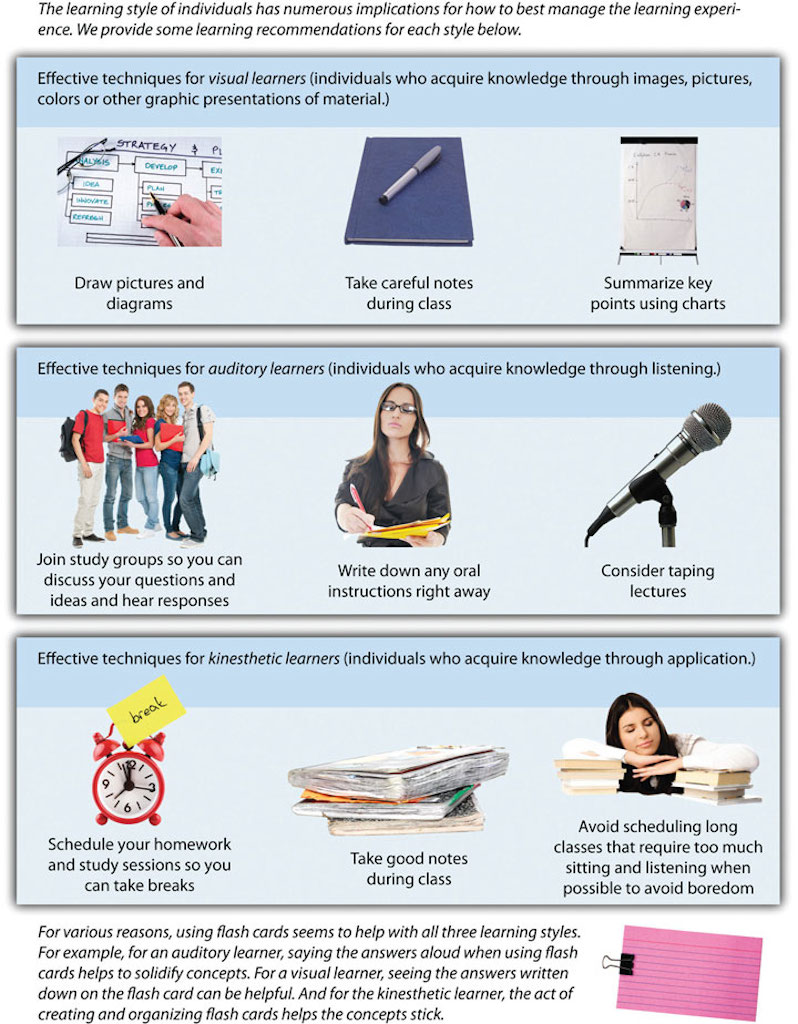1.3 Understanding Learning and Your Learning Style
Learning Objectives
Understand different dimensions of learning styles.
Diagnose your own learning style.
Explore strategies for working with your preferred learning style.
Learning
Have you ever wondered how humans learn? Learning is defined as a relatively permanent change in knowledge or skill produced by experience. Let’s break down this definition to emphasize the key pieces needed to establish that learning has taken place. First, no learning has occurred if it is not lasting. Second, if a person already knew the content and then took a test and scored 100%, that doesn’t indicate learning happened recently; of course, at some point, this person learned the material on the exam. Finally, experience can occur in many ways. Hearing about another person's experience, reading a book, or practicing a new skill are all types of experiences. However, as simple as the definition of learning is, we know that learning is a complex process. Factors affecting whether learning takes place include learner characteristics such as ability, readiness, and motivation to learn. The learning environment and context also matter, such as the location where learning takes place, what needs to be learned, and how similar or dissimilar the new knowledge or skill is to previous learning. Another factor is how often a learner will use the newly acquired knowledge or skill. For example, bank employees often “overlearn” procedures to be followed during a bank robbery. In other words, they practice repeatedly even after acquiring the basic skills because while an actual robbery is relatively rare, and hostages being taken is even more rare, the stakes are high to perform well during one.
Another key aspect when thinking about learning is how much is retained over time and how we can enhance retention. We do know that the retention of information three days after a meeting or other event is six times more effective when information is presented using a combination of visual and oral modes when compared to only speaking. This makes sense as 83% of human learning takes place visually for those with intact vision. Retention is also enhanced when learners are active participants. Benjamin Franklin is quoted as saying “Tell me and I forget. Teach me and I remember. Involve me and I learn.” When adult learners are asked to engage in group discussions, practice what they’ve learned, and teach it to others, they are actively learning. Conversely, when they listen to a lecture, read a textbook, or see a demonstration, they are receiving information more passively. In addition, research shows that individuals absorb more when taking handwritten notes than typing notes on laptops. The researchers posit that those who take notes by hand spend more time and energy rewriting what they hear in a lecture into their own words while those using laptops tend to transcribe the lecture verbatim without absorbing as much of it. Next, we turn our attention to learning styles and their role in how individuals learn.
Learning Styles
To maximize your learning in this course and in any learning situation, it’s important to understand what type of learner you are. Some people learn better by seeing information. For example, if you notice that you retain more information by reading and seeing diagrams and flow charts, you may be a visual learnerOne who processes information most effectively by looking at words and diagrams.. If you primarily learn by listening to others such as in lectures, conversations, and videos, you may be an auditory learnerOne who processes information most effectively by listening or talking.. Finally, if you have a preference for actually doing things and learning from trial and error, you may be a kinesthetic (tactile) learnerOne who processes information most effectively by actively engaging with the material.. If you are unaware of what your primary learning style is, take a moment to diagnose it at the website listed below.
What Is Your Learning Style?
Take the following online learning style quiz to find out what type of learning style you have:
Keep in mind that while individuals tend to have a dominant, or primary, learning style, being able to adapt to different learning situations is a big plus, so anytime you get a chance to learn in a new way, grab it. The more you practice, the better you will become at learning to process information in different ways.
Key Takeaway
People tend to have a preferred learning style. Visual learners see things to learn them. Auditory learners hear things to learn them. Kinesthetic learners do things to learn them.
What do you think?
Were you surprised by your primary learning style? Why or why not?
How does your learning style affect the kinds of classes you take?
Try out a few of the suggestions for your learning style over the next week and see how they work.
Now that you’ve learned more about your own learning style, are there some things you might consider doing to expand on your other styles? If so, what steps might you take to do this?

